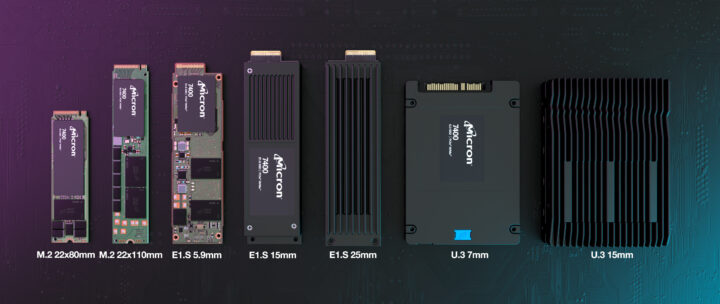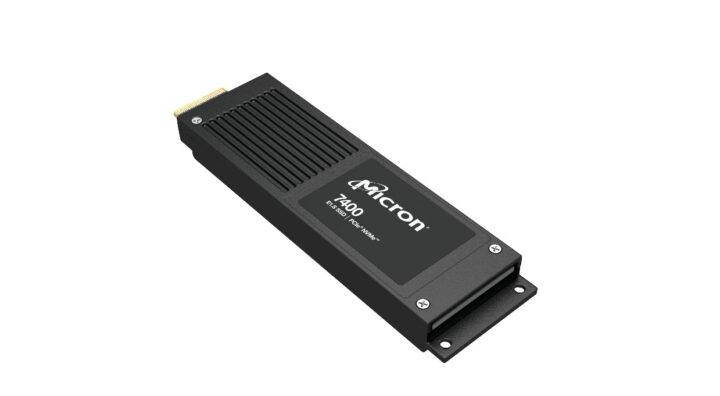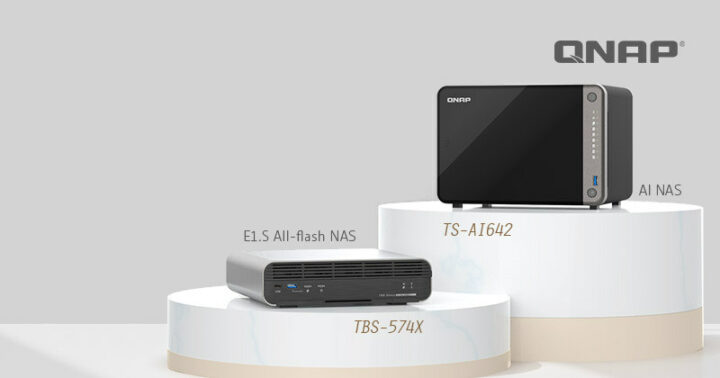QNAP has been teasing two potentially interesting NAS coming up soon: the TS-AI642 AI NAS leveraging the 6 TOPS NPU in Rockchip RK3588 Arm processor for image and facial recognition, and the TBS-574X NAS powered by an Intel Core i3-1220P Alder Lake CPU and taking up to five hot-swappable E1.S NVMe PCIe SSDs.
Details are limited since neither device is available yet, but both NAS are equipped with relatively powerful Arm and Intel processors and offer some innovative features.
QNAP TBS-574X NAS with Rockchip RK3588
Preliminary specifications:
- SoC – Rockchip RK3588 octa-core 64-bit Arm processor with 4x Cortex-A76 cores @ 2.2 GHz, 4x Cortex-A55 cores @ 1.8 GHz, 6 TOPS NPU
- Storage – 6x SATA III bays
- Video Output – 2x HDMI 2.1 ports
- Networking – Built-in 2.5GbE, PCIe Gen 3 slot for 10GbE module
The main highlight is the 6 TOPS AI accelerator that boosts the performance of the QNAP AI Core engine notably in “QVR Face” facial recognition solution, “QVR Smart Search” surveillance event search, and “QuMagie” AI photo albums. This can be used to search your photos more easily, as well as for video surveillance applications that can benefit from the two HDMI output ports.
Last year, QNAP introduced the TS-133 1-bay NAS making use of the Rockchip RK3566 AI capabilities for object and face recognition, but it comes only with a 0.8 TOPS NPU, so the Rockchip RK3588 model should offer much faster image recognition.
TBS-574X NAS with E1.S SSD
When I wrote about the QNAP TBS-464 NAS taking up to four M.2 NVMe SSDs in October 2021, I noted the ultra-thin design, but I did not realize it would remove one important feature of network attached storage devices: the ability to hot-swap drives. You’d need to turn off the device, insert the M.2 SSD, and tighten the screw whenever you wanted to add or replace a drive.
It turns out the industry has come up with the EDSFF form factor, mostly designed for data centers, that enables hot-swapping SSD drives among other things. There are three form factors: E1.L (EDSFF 1U Long) that’s 318.75mm long and designed for server racks, the more compact E1.S (EDSFF 1U Short) measuring 111.49 x 31.5mm and with a 5.9mm to 25mm thickness that depends of the use and type of enclosure, and the larger E3.L and E3.S for higher capacities and with a power envelope of up to 70W.


QNAP addresses the lack of support for host-swappable SSDs in the TBS-464 by taking up to five E1.S SSDs in the new TBS-574X NAS model.
QNAP TBS-574X preliminary specifications:
- SoC – Intel Core i3-1220P 10-core/12-thread Alder Lake-P processor with 2 P-cores @ up to 4.40 GHz and 8 E-cores, 64EU Intel Xe graphics suitable for transcoding and editing 4K videos; PBP: 28W
- System Memory – 16GB RAM
- Storage – 5x bays for E1.S SSDs up to 15mm thick each with E1.S to M.2 2280 NVMe SSD adapter in each bay; up to 30TB using 7.68TB drives
- Video Output – HDMI port up to 4K resolution
- Networking – 2.5GbE and 10GB
- USB – 2x USB4 ports up to 40 Gbps
| Type | Width | Length | Thickness |
|---|---|---|---|
| E1.S 5.9mm | 31.5mm | 111.49mm | 5.9mm |
| E1.S 8mm heat spreader | 31.5mm | 111.49mm | 8.01mm |
| E1.S Symmetric Enclosure | 33.75mm | 118.75mm | 9.5mm |
| E1.S Asymmetric Enclosure | 33.75mm | 118.75mm | 15mm |
| E1.S Asymmetric Enclosure | 33.75mm | 118.75mm | 25mm |
The table above shows the various dimensions for E1.S SSDs, and that means most E1.S should work in the NAS, except for the thicker 25mm drive. The model with an asymmetric enclosure will probably be recommended for better cooling. QNAP says the TBS-574X is also suitable for 2K/4 video transcoding, real-time 4K video production, and business IT applications.
QNAP will officially launch the two NAS later this year, and we’ll know pricing at the time of launch. E1.S SSDs still appear to be hard to find, and for instance, nothing shows up on Amazon, except some PCIe to E1.S adapters. I also had a look at the Micron 7400 E1.S SSD, and searching for a particular model include looking in the product brief to come up with a part number such as MTFDKBZ1T9TDZ that is a 1,920 GB E1.S Pro bare SSD with 5.9mm thickness and sold on Newark for about $550, but out of stock.
More details may be found in QNAP’s announcement. Thanks to TLS for the tip.

Jean-Luc started CNX Software in 2010 as a part-time endeavor, before quitting his job as a software engineering manager, and starting to write daily news, and reviews full time later in 2011.
Support CNX Software! Donate via cryptocurrencies, become a Patron on Patreon, or purchase goods on Amazon or Aliexpress





